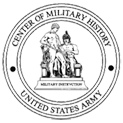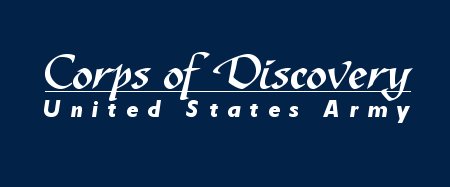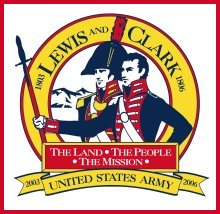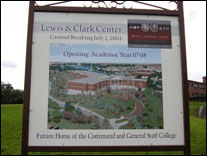 |
A ground breaking ceremony was held at Fort Leavenworth, Kansas on 1 July 2004 for the new U.S. Army Command and Staff College, which will be named after Captains Lewis and Clark. The facility, which will be completed in 2007, will house 1,500 students and 800 faculty/staff. |
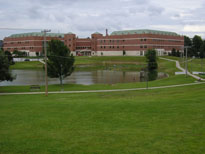 |
The “Lewis and Clark Center” will be located adjacent to the Combined Arms Research Library, which is pictured here. |
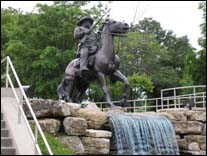 |
Once construction is completed, “Lewis and Clark Center” will be also be located near the Buffalo Soldiers Monument honoring those African-Americans who served in the 9th and 10th U.S. Cavalry Regiments. |
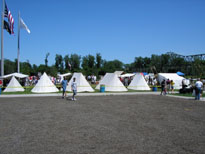 |
One of the period military encampments erected by interpreters in downtown Atchison, Kansas. |
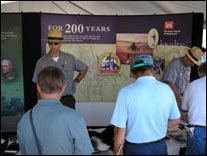 |
Visitors had many opportunities to learn more about the members of the expedition at the U.S. Army Corps of Engineers display booth in Atchison. |
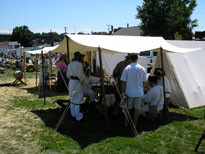 |
Another view of Jeffersonian era soldiers in their encampment located in downtown Atchison. |
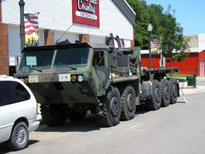 |
HEMETT transport vehicle of the Kansas National Guard parked in Atchison, Kansas. This vehicle, which belongs to the 1 st Battalion, 127 th Field Artillery, was used to transport the 75mm saluting battery that participated in the Fourth of July celebration. |
|
Veterans Memorial Park in Atchison, Kansas, location of the downtown commemorative activities honoring Lewis and Clark. |
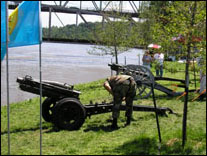 |
Saluting piece (75mm WW2 pack howitzer used by airborne troops) belonging to the 1 st Battalion, 127 th Field Artillery (KS Army National Guard) in Veterans Memorial Park prior to the evening celebration. |
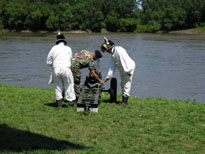 |
Jeffersonian-era Army artillerists get a chance to practice firing a “modern” artillery piece. |
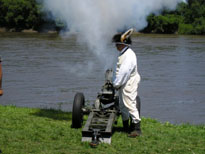 |
Pulling the lanyard! |
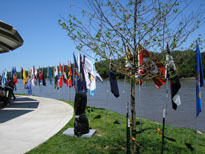 |
Another view of Veterans Memorial Park in Atchison, located on the scenic western bank of the Missouri River. |
|
Lewis and Clark’s entire flotilla is visible here. It is easy to see why the expedition distinguished between the smaller vessels (called pirogues) by their hull color (white and red). The largest of the three vessels (today it is commonly referred to as a “keelboat” but Lewis and Clark called it “the barge”) is furthest from the camera. |
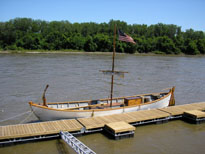 |
The “White” pirogue (similar in design to a Boston Whaler). |
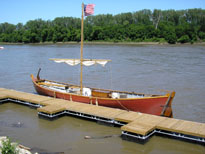 |
The “Red” pirogue. |
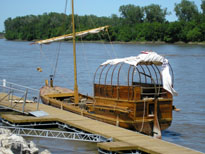 |
The “keelboat” aka “The Barge”. |
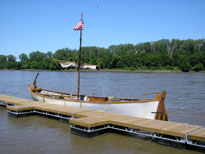 |
Another view of the “White” pirogue – note the rudder mounted on the stern. |
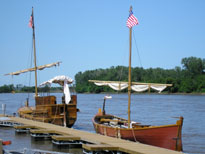 |
A view that allows a comparison to be made in regard to the relative size of the keelboat and “Red” pirogue. |
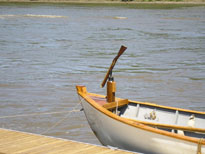 |
Close-up of the pintle mount of the boat gun on the bow of the “White” Pirogue. This mounting gave the weapon added stability during firing as the recoil of the weapon is absorbed by the ship. The boat gun (also known as a “Blunderbuss”) is defined as “short musket of wide bore and flaring muzzle, formerly used to scatter shot at close range.” It was used by naval vessels to “discourage” boarding parties. |
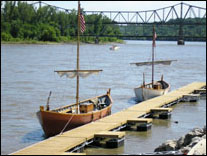 |
A view of the “Red” and “White” pirogues. Note the American flag on each mast. |
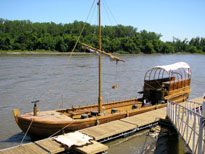 |
Close up of Lewis and Clark’s “flagship” as indicated by the white commanding officers pennant flying from the stern. |
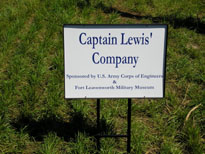 |
The U.S. Army Corps of Engineers has organized a group of interpreters dedicated to faithfully portraying the members of the expedition as they crossed the continent on their way to the Pacific Ocean. |
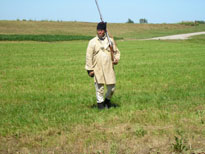 |
An interpreter dressed in Jeffersonian era “fatigue uniform” stands guard at the U.S. Army Corps of Engineers period encampment located at the exact site (Independence Creek) that Lewis and Clark commemorated the Fourth of July in 1804. This camp was actually located several miles outside modern day Atchison. The State of Kansas installed a marker at the actual site. |
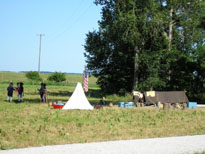 |
A view of the tented Jeffersonian era military encampment established by the U.S. Army Corps of Engineers at Independence Creek, KS. |
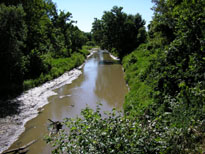 |
Independence Creek as seen from the rear of the U.S. Army Corps of Engineers encampment (the water level is extremely low due to lack of rain for an extended period of time). |
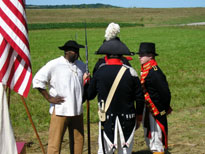 |
A scene where several members of the expedition, including Captain Lewis, as conversing with York. |
|
Captain Lewis as portrayed by Mr. Steve Allie of the Fort Leavenworth Living History Association. |
|
This is how nineteenth century soldiers normally stacked their muskets while in camp. |
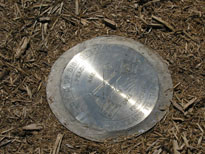 |
The newly installed State of Kansas historical marker at Independence Creek. |
|
Dr. Hal Stearns (portraying William Clark in later life) chats with two admirers at the Independence Creek encampment. |
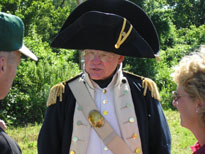 |
Dr. Stearns is wearing the uniform of a Brigadier General (a rank eventually reached by Clark). In 1807 Thomas Jefferson appointed him principal Indian agent for the Louisiana Territory and brigadier general of its militia, posts which he occupied until 1813, when he became governor of the newly-formed Missouri Territory. |
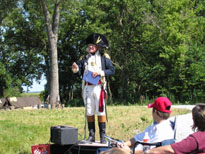 |
Dr. Stearns is seen here entertaining visitors to the encampment with a speech that William Clark might have given himself as he reflected upon the achievements of the expedition in later years. |
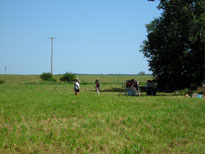 |
Soldiers prepare to toast the Fourth of July. |
|
The U.S. Army Corps of Engineers interpreters freely mingled with visitors, answering numerous questions about the expedition and Army life during the Jeffersonian era. |
|
Full length photograph of Dr. Stearns in Jeffersonian uniform. |
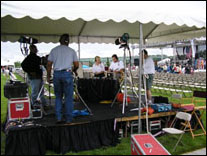 |
The showcase event of “A Journey Forth” in Kansas City, Missouri took place on 3 July in Berkley Riverfront Park. Here we can see a local television news station preparing to broadcast the day’s events. |
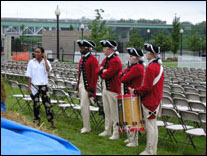 |
Soldiers from the U.S. Army Old Guard Fife and Drum Corps (stationed at Fort Myer, VA) who participated in the activities at Berkley Park were also interviewed by local reporters. |
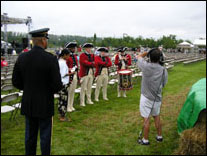 |
Another view of the members of the Old Guard Fife and Drum Corps being interviewed on live Television. |
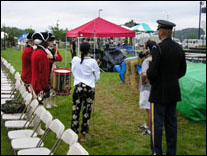 |
Wrapping up the interview! |
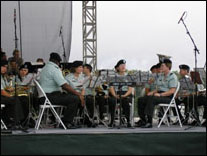 |
The 135th Army Band (Missouri National Guard) provided marvelous entertainment to the crowds gathering for the event at Berkley Park on 3 July. |
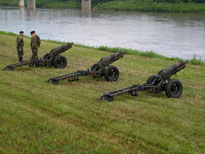 |
Missouri National Guard saluting battery located behind the main stage at Berkley Park. |
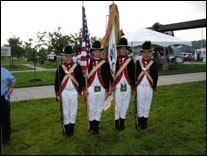 |
The Official U.S. Army 1802 Lewis and Clark Color Guard. |
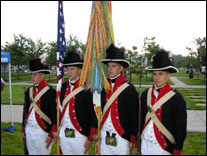 |
These Soldiers are all members of A Company, 3rd U.S. Infantry (The Old Guard) stationed at Fort Lesley J. McNair, District of Columbia. |
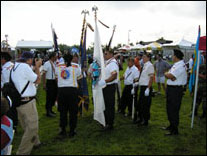 |
Members of the American Indian color guard who also participated in the event. |
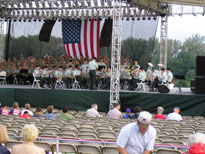 |
Invited guests begin to gather at Berkley Park shortly before 10 a.m. on Saturday, 3 July 2004. |
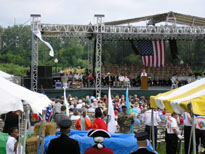 |
In a short while it was virtually standing room only as the dignitaries began arriving. |
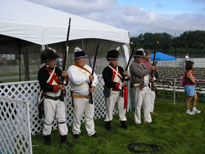 |
Interpreters dressed as Jeffersonian soldiers present arms as they salute the playing of the National Anthem. |
|
Several of the Non-Commissioned Officers from The Old Guard who accompanied the Fife and Drum Corps chat with the Soldiers who compose the U.S. Army Official 1802 Lewis and Clark Color Guard. |
|
The U.S. Army Official 1802 Lewis and Clark Color Guard prepares to present the National Colors and U.S. Army flag at Berkley Park. |
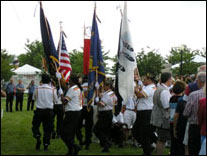 |
The American Indian Color Guard prepare to present the National, State, and tribal colors. |
|
The U.S. Army Parachute Team, also known as “The Golden Knights”, also took part in the ceremony. The Golden Knights have performed more than 12,060 shows in all 50 states and 48 countries. Annually the Team performs more than 27,000 jumps before an estimated 12 million people. |
|
An Army jumper slows just prior to landing directly atop a ground marker during a precision jump demonstration. The Golden Knights’ parachute competition teams, Style and Accuracy team, and the eight-way formation skydiving team, have circled the globe competing in parachuting competitions. Their professional credentials include 20 national and six world team titles. In addition to those accomplishments the Golden Knights can claim having the only six-time world champion parachutist in formation skydiving. These impressive achievements have made them not only the most successful U.S. Department of Defense sports team, but also the most successful parachute team in the world. |
|
Specialist Jon Ewald, a member of the Golden Knights, narrates events at Berkley Park. |
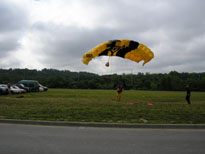 |
Jumpers gather up their parachutes at Berkley Park. |
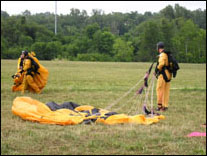 |
A Soldier who wants to become a Golden Knight must first apply to attend the Assessment and Selection Program. Selection is held every year at the Team’s home, Fort Bragg, N.C. Any enlisted Soldier can apply, however, only those who meet the demanding qualifications are selected. Applicants must volunteer, have a minimum of 150 freefall parachute jumps, have a flawless military and civilian record and be willing to attend the Army’s Airborne School, if necessary. The six week Assessment and Selection Program tests parachuting skills, challenges the physical, mental and emotional states of the candidates and builds teamwork to help identify the best Soldiers for the team. |
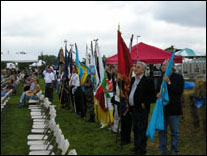 |
Here you can see the crowds intently watching the Golden Knights as they approach Berkley Park. |
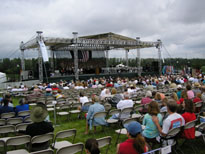 |
Once the Golden Knights performance was complete, attention turned once more to center stage as the many attending dignitaries made their remarks. |
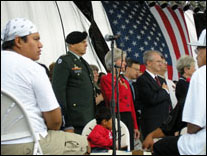 |
Lieutenant General William S. Wallace, commanding general of the Combined Arms Center and Fort Leavenworth, was featured as the keynote speaker for the Berkley Park commemorative event. |
|
In his speech that morning, General Wallace pointed out that just like today’s Soldiers, Captains Lewis and Clark unhesitatingly answered their nation’s call when President Thomas Jefferson asked them to lead an expedition to the Pacific Northwest. |
